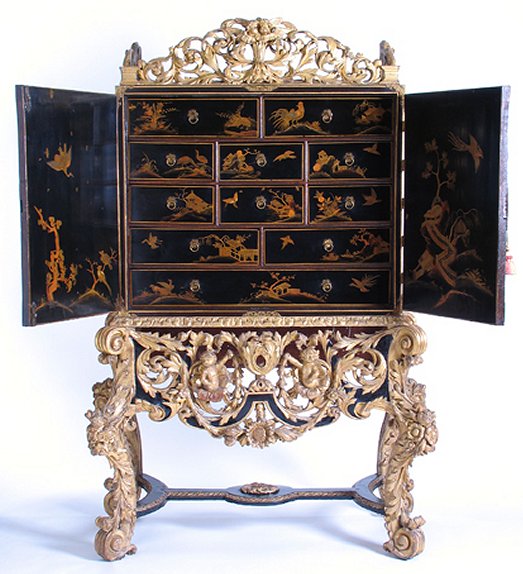It doesn’t happen too often, but from time to time we are asked from where we get the items we offer, and what we paid for them. Slightly intrusive, but reasonable, I suppose, in that what we sell is not inexpensive, and those who have the money to purchase are not in the main, shall we say, supine.
We prefer to source our material privately as there is cachet attached to items that are fresh to the market, something, say, that has been out of sight for perhaps centuries. This happens to us from time to time, with exciting results. Witness a late 17th century lacquer cabinet on stand, lost from view in the last century, but acquired by us and determined to have a singular provenance- and sold by us to someone in the entertainment field of equal singularity.
We do, though, make the occasional purchase at auction. The major auction houses, despite their onerous commission charges, nevertheless seek to be a retail vendor of period and contemporary fine and decorative art and have done their level best to erode the established retail trade in art and antiques. I read not so long ago an interview with a gentleman I know from The Georgian Group, and an employee of Christie’s. Married to an aristocrat and spending most of his time in the family pile, in his interview he decried the depleting numbers of countryside dealers. His tears doubtless of the crocodile variety, as his efforts are working a treat to dispatch the trade from this mortal coil.
Nevertheless, auctions remain a source for very many dealers, and just at the moment, vaunted Bond Street dealer Richard Green is in the soup, sued by a buyer of two old master paintings claiming that the dealer should have disclosed the pictures were only recently purchased at auction. This is true- a Brueghel purchased in November, 2017, and a Ruysdael purchased at Sotheby’s in June, 2017, were then sold by Richard Green to complainant Gary Klesch at TEFAF Maastricht in March, 2018.
In this imbroglio I am firmly on the side of dealer Richard Green. How our stock is sourced, beyond the simple statement that it was sourced through legitimate channels, is nobody’s business. As I have written before, whatever we’ve acquired at auction was always at a price that justified the time we spent examining the piece beforehand to judge its quality and condition, attending the sale on the day, laying down our money for purchase, transporting it away, paying for its (inevitable) restoration to put it in saleable condition, and then and only then, offering it for sale. For us, since we started in business, we have divined two tiers within the trade- a wholesale price and a retail price, and be assured, there is for us and most of the dealers in the accredited trade, significant value added by the time a piece is offered for retail sale.
All that said, to stay in business our stock in trade must be priced to sell. In the case of Richard Green, The Antiques Trade Gazette quotes a gallery spokesman as saying ‘…there are very good comparables (to the paintings sold to Gary Klesch)…’ As well there must be. The fine art databases, as well as those of the major auction houses, are replete with detail, including the recent sale records of the two paintings purchased by Richard Green and resold to Mr Klesch. What’s more surprising, and makes Mr Klesch’s claim markedly less credible, is the vocation of his wife with whom he examined and purchased the paintings. Dr Anita Klesch is a research fellow in the department of the history of art at Birkbeck College, one of the constituent colleges of the University of London. As her CV on Birkbeck’s website indicates, her speciality is the effect of information technology on the history of art, and the uses of digital imagery in education. Hmmm…presumably the ‘digital imagery’ and ‘education’ referenced in her CV was not self-directed and therefore did not extend to her own purchases.
We do ourselves have recalcitrant, although not litigious, clients. Though rarely and not recently we have been chided by an erstwhile client or two about matters associated with their purchase that while niggling and specious basically boiled down to a case of buyer’s remorse. We have this particular phenomenon in common with Richard Green, and doubtless that gallery’s invoices make the same disclaimers as to price as well as condition. Also, the prospective buyer is assumed- and given our price points it is a very, very reasonable assumption- that the buyer is sufficiently sophisticated to ask whatever questions they might- from us or any other expert they wish to consult.



